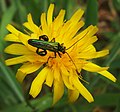| Gunnersbury Triangle | |
|---|---|
IUCN category IV (habitat/species management area) [1] | |
 Acid grassland and birches on old railway track | |
 | |
| Location | Hounslow/Ealing |
| Nearest city | London, England |
| Coordinates | 51°29′39″N0°16′6″W / 51.49417°N 0.26833°W |
| Governing body | London Wildlife Trust |
| www | |
Gunnersbury Triangle is a 2.57-hectare (6.4-acre) local nature reserve in Chiswick, in the London boroughs of Ealing and Hounslow, [2] [3] immediately to the east of Gunnersbury. It was created in 1983 when, for the first time in Britain, a public inquiry ruled that a planned development of the land could not go ahead because of its value for nature. It opened as a nature reserve in 1985.
Contents
- History
- Reserve
- Habitats
- Usage
- Value
- Biodiversity
- Activities
- Notes
- References
- Sources
- External links
The area consists mainly of secondary birch woodland, with some locally uncommon willow carr or wet woodland and a small area of acid grassland along the track of the former Acton curve railway. The reserve supports a varied population of plants, birds, amphibians, insects and other wildlife. It is managed by the London Wildlife Trust. [4]
The reserve is maintained by London Wildlife Trust staff with the help of volunteers, and is open to the public. There is a varied programme of activities including wildlife walks, fungus forays, open days and talks. The reserve is used regularly by school and community groups, and for team-building work days by corporate groups. Its entrance, with a wooden five-bar gate flanked by hedges, is on the south of Bollo Lane, a few yards from Chiswick Park Underground station.
























































































































































































































































































































































